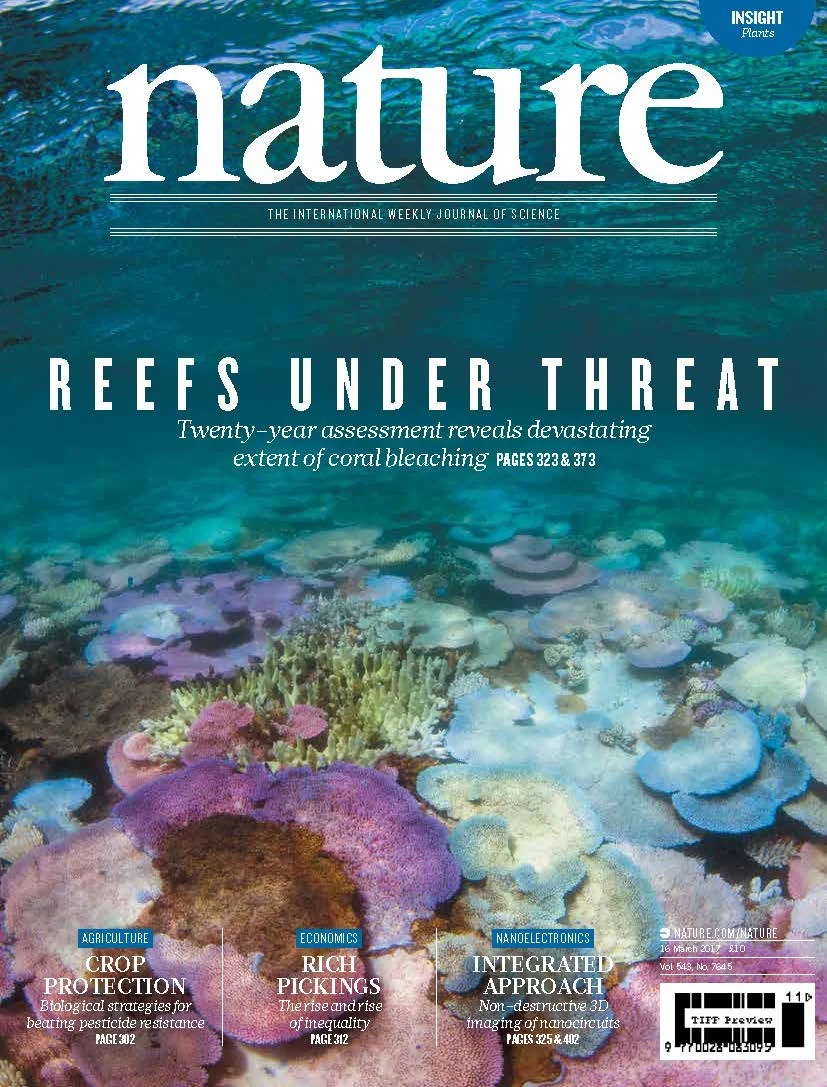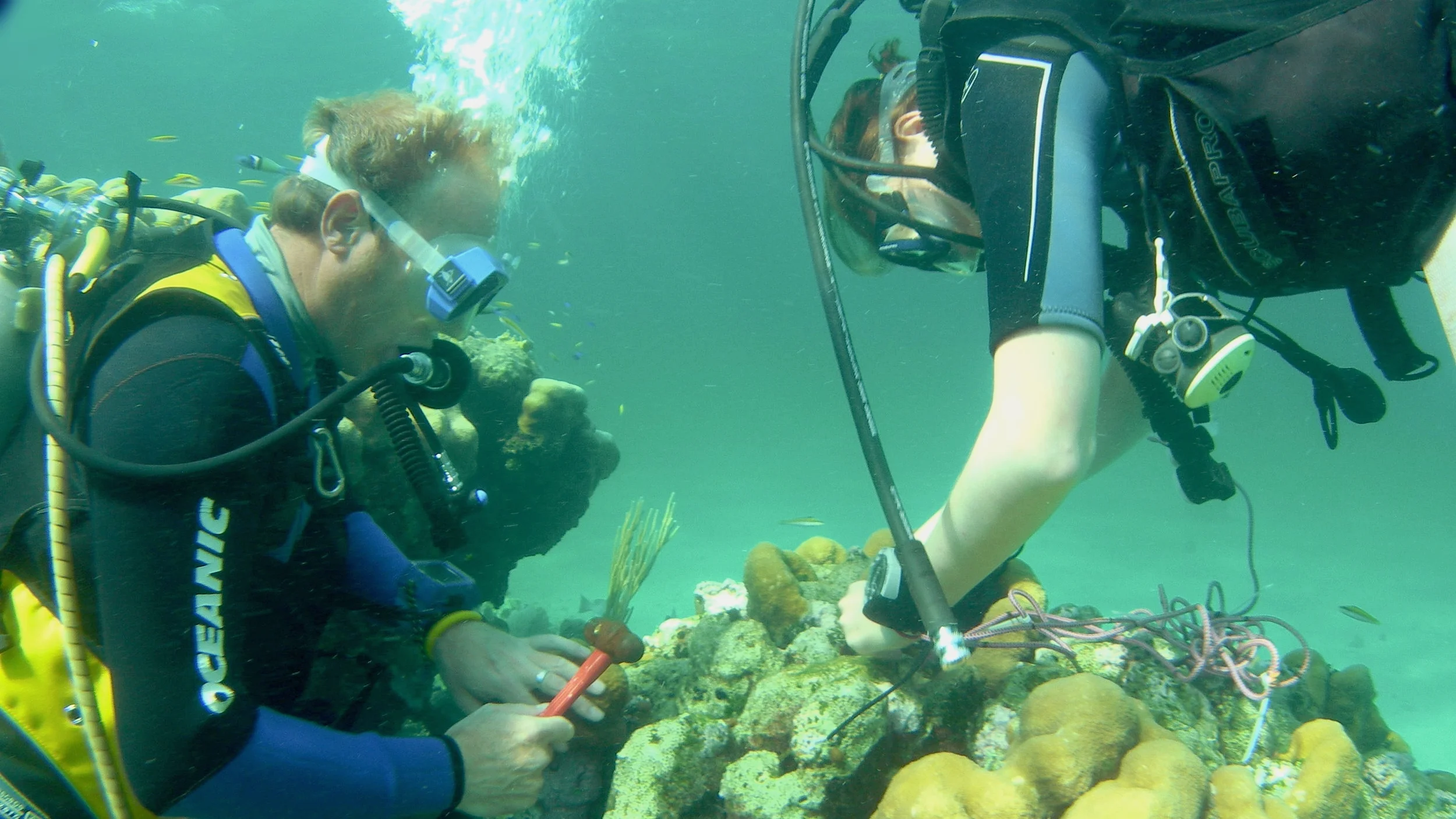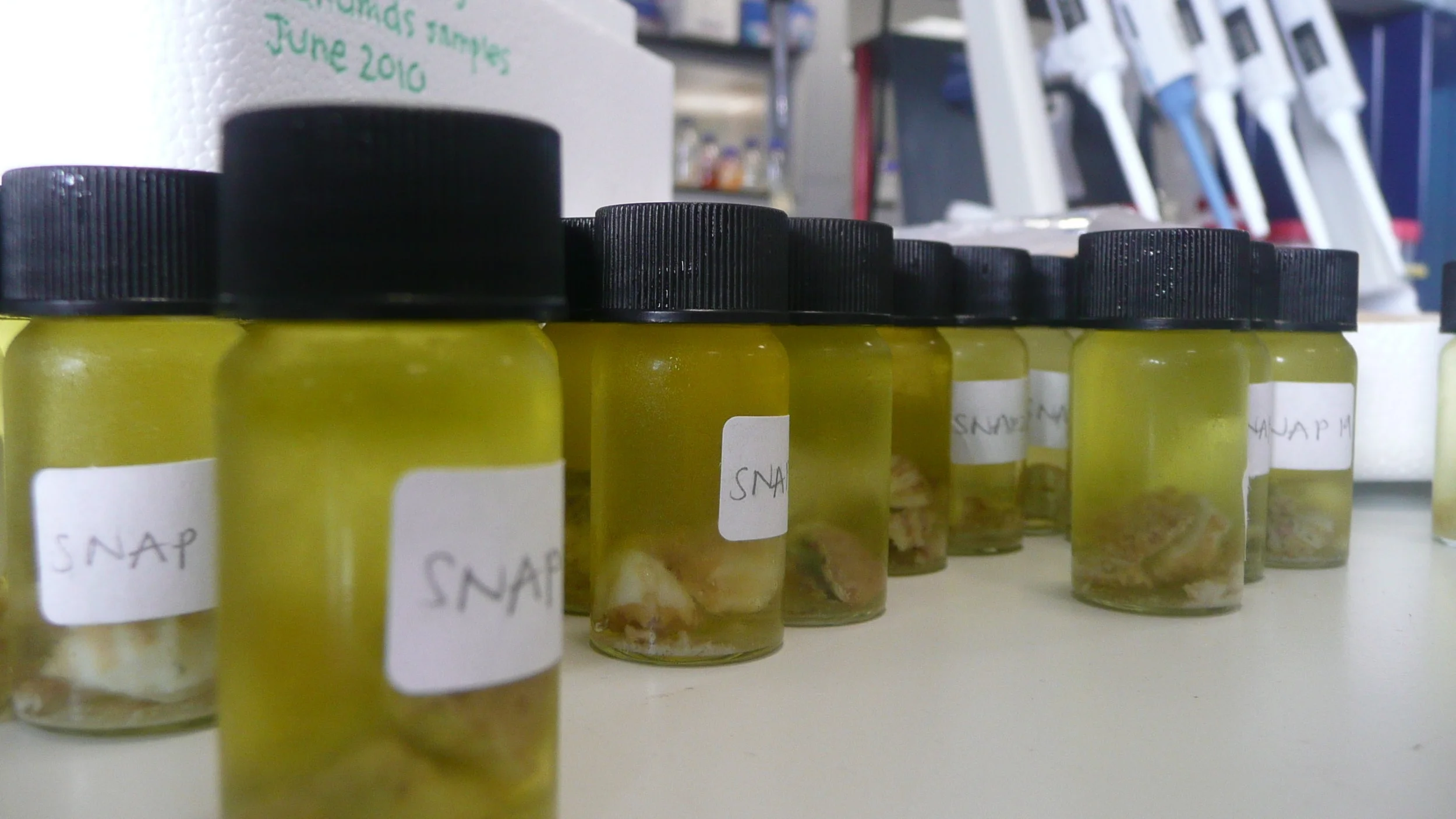




Research themes
Research
Research themes
Research
See what our lab got up to on our latest survey expedition in the Coral Triangle
Research themes
My formal training was as a zoologist, but I have a broad range of research interests. I have been lucky enough to research a broad range of topics examining coral reef ecology from the micro- to macro scale. Below are listed some of my current areas of research interest.
Please get in touch if you would like to collaborate!
CARBONATE BUDGETS
Provision of coral reef goods and services (e.g., sand production, coastal protection, habitat availability) are closely associated with the ability of coral reefs to maintain complex three-dimensional structure through growth. Carbonate budgets (a measure of ability of reefs to create structural growth) are a holistic way of assessing coral reef health, going beyond traditional methods of fish and coral abundance.
Few comprehensive carbonate budgets exist for Australian reefs. As part of an Australian Endeavor Fellowhship, I am producing the first comprehensive set of carbonate budgets for the Great Barrier Reef, following existing census-based field methodologies. The overarching goal is a better understanding of Australian reef functioning in terms of ability to maintain positive carbonate budgets.
CORALLINE ALGAE
Coralline algae promote coral recruitment, strengthen and stabilize reef framework through cementation, and contribute to reef framework construction: these roles underpin vital ecosystem services provided by reefs.
As part of a Great Barrier Reef Foundation funded project, I have been investigating the responses of coralline algae - a critical component of reefs - to climate change, namely ocean acidification and warming sea temperatures.My work involves a combination of deskwork (meta-analyses of published work) and field and lab experiments at Heron Island, with the aim of producing a tool for monitoring the effects of climate change, that can be employed on the Great Barrier Reef and beyond.
REEF BIOACOUSTICS
Coral reefs are surprisingly noisy places: invertebrates and fish produce a cacophony of sounds – a “dusk chorus” – that can be heard up to 15 km away from the reef. As sound travels more efficiently through water than air, many marine organisms (including larval fish) use reef noise to orient themselves out at sea, and navigate their way to coral reefs. I’m interested in understanding how sound reflects habitat quality: I look for patterns in recordings I make of coral reefs, to see what listening to nature can tell us about how healthy a reef is.

Research themes 2
Research themes 2
DGGE gels are used to ID the Symbiodinium hosted by each coral colony
SYMBIODINIUM
As part of my PhD I investigated the diversity of dinoflagellate endosymbiont communities in the tissues of Orbicella annularis, an important – and endangered – reef building coral in the Caribbean.
The survival of the O. annularis host relies on nutrition provided by the algal symbionts (known as zooxanthellae, genus Symbiodinium). Symbiodinium demonstrate sensitivity to environmental settings such as light, temperature and water chemistry, and under extreme conditions communities may be reduced, damaged or lost, causing corals to ‘bleach’.
O. annularis host a variety of algal symbiont types, yet the diversity of community assemblages had not been documented over a wide-geographic range. My project used a non-coding region of ribosomal DNA called ‘ITS2’ to identify the composition of zooxanthellae communities down to sub-cladal level, in samples of O. annularis from 45 sites across the Wider Caribbean region, from Barbados to the Bahamas. Spatial patterns of diversity across the region were compared to environmental factors (including regional SSTs, aragonite saturation state, salinity), region, and host genotypes, based on six microsatellite markers.
Echinometra the boring rock urchin, snuggled away in a crevice during the day to avoid predation.
BORING ORGANISMS
They're not actually boring at all! Bioeroders (or "boring" organisms) burrow into the limestone coral reef framework, breaking down structure. Relatively little is known about the coral reef bioeroding community - which consists of microborers (bacteria, fungi and algae), macroborers (sponges and bivalves) and grazers (urchins and parrotfish) that wear away reefs from the outside. As part of my research on carbonate budgets I have become fascinated with bioeroders, and am working on several collaborative projects to characterise the boring activity of urchins (with Dr. Trisha Atwood, Lizard Island) and sponges (with Dr Christine Schonberg, Orpheus Island) on the Great Barrier Reef.
BRITISH BATS
The following is placeholder text known as “lorem ipsum,” which is scrambled Latin used by designers to mimic real copy. Nulla lectus ante, consequat et ex eget, feugiat tincidunt metus. Mauris id fermentum nulla.

Scientific Publications
Publications
Scientific Publications
Publications
Journal publications
Below are a list of selected scientific publications. Please contact me if you can't access the full version of the text in the links provided, and I can email you a copy of the paper.
Global warming and recurrent mass bleaching of corals
During 2015–2016, record temperatures triggered a pan-tropical episode of coral bleaching, the third global-scale event since mass bleaching was first documented in the 1980s. Here we examine how and why the severity of recurrent major bleaching events has varied at multiple scales, using aerial and underwater surveys of Australian reefs combined with satellite-derived sea surface temperatures. The distinctive geographic footprints of recurrent bleaching on the Great Barrier Reef in 1998, 2002 and 2016 were determined by the spatial pattern of sea temperatures in each year. Water quality and fishing pressure had minimal effect on the unprecedented bleaching in 2016, suggesting that local protection of reefs affords little or no resistance to extreme heat. Similarly, past exposure to bleaching in 1998 and 2002 did not lessen the severity of bleaching in 2016. Consequently, immediate global action to curb future warming is essential to secure a future for coral reefs.
Hughes TP, Kerry JT, Álvarez-Noriega M, Álvarez-Romero JG, Kennedy EV et al. 2017. Global warming and recurrent mass bleaching of corals. Nature 543: 373-377. doi: 10.1038/nature21707
COMPARISON OF RECRUITMENT TILE MATERIALS FOR MONITORING CORALLINE ALGAE RESPONSES TO A CHANGING CLIMATE
Settlement plates are widely used in ecological studies as a simple and effective way to assess recruitment and growth of sessile benthic communities. Using different plate types can affect study reproducibility and skew results, yet no standardised guidelines exist for monitoring crustose coralline algae (CCA), a key bioindicator of changing seawater carbonate chemistry. Here, we compare experimental tile materials (including plastic, ceramic and glass tiles) at two orientations (horizontal and vertical) for CCA community recruitment and calcification across three reef habitats (back reef, fore reef crest and reef slope). Community composition varied with tile material and orientation. Vertically oriented surfaces and plastic and limestone tiles produced the closest approximation of real-world communities. Horizontal surfaces appeared to encourage coralline recruitment, particularly in light-limited environments, but also attracted greater herbivory. PVC tiles were the optimal approach when all factors were considered, as they generated a percent cover representative of adjacent reef communities and produced more consistent calcification estimates (across space and time), as well as being cheaper and easier to work with. Selection of plate type and deployment methods will ultimately depend on the experimental question; here we describe the benefits and costs of each material and/or orientation and suggest the adoption of PVC tiles as an optimal overall approach for monitoring CCA.
Kennedy EV, Ordońez A, Lewis B, Diaz-Pulido G. 2017. Comparison of recruitment tile materials for monitoring coralline algae responses to a changing climate. Marine Ecology Progress Series. doi: 10.3354/meps12076
AVOIDING REEF FUNCTIONAL COLLAPSE REQUIRES LOCAL AND GLOBAL ACTION
Most reef functions and ecosystem services are founded on the ability of reefs to maintain their three-dimensional structure through net carbonate accumulation. Coral growth only constitutes part of a reef’s carbonate budget; bioerosion processes are influential in determining the balance between net structural growth and disintegration. Here, we combine ecological models with carbonate budgets and drive the dynamics of Caribbean reefs with the latest generation of climate models. Budget reconstructions using documented ecological perturbations drive shallow (6–10 m) Caribbean forereefs toward an increasingly fragile carbonate balance. We then projected carbonate budgets toward 2080 and contrasted the benefits of local conservation and global action on climate change. Local management of fisheries (specifically, no-take marine reserves) and the watershed can delay reef loss by at least a decade under “business-as-usual” rises in greenhouse gas emissions. However, local action must be combined with a low-carbon economy to prevent degradation of reef structures and associated ecosystem services.
Kennedy EV, Perry CT, Halloran PR, Iglesias-Prieto R, Schönberg CHL, Wisshak M, Form AU, Carricart-Ganivet JP, Fine M, Eakin CM, Mumby PJ. 2013. Avoiding coral reef functional collapse requires local and global action. Current Biology 23:912-917.
Featured in: NERC Planet Earth Online, BBC Spotlight. Bruno, J. 2013. Coral Reefs: Building a Better Crystal Ball. Current Biology 23, R473-R475 praised the work done as “zeroing in on a key ecosystem function” and “really driving home the value of science”

Collaborators
Collaborators
Collaborators
Collaborators
Past labs
The furtherment of human knowledge comes from building on foundations of previous discoveries of past researchers.
I strongly believe that science has to be a collaborative process, and very the best scientific advancements come from team work.
I have been very fortunate to work in a number of outstanding research labs around the world, who have encouraged my professional development and provided a supportive environment in which to develop as a research scientist.
"If we see further it is by standing on the shoulders of giants" - Issac Newton (1675)
GLOBAL CHANGE INSTITUTE
The Global Change Institute (GCI) at The University of Queensland is where Emma currently works. The GCI, established in 2010, is an independent source of innovative research, ideas, policy and advice for addressing the challenges of a changing world.
Led by Professor Ove Hoegh-Guldberg, the GCI works to address the impacts of climate change and population growth through collaborative research across themes such as clean energy, food systems, and healthy oceans.
CORAL REEF ALGAE LAB
Headed by A/Prof. Guillermo Diaz-Pulido, the coral-reef algae lab at Griffith University is interested in physiological, biogeochemical, ecological & conservation questions related to tropical marine algae and coral reefs.
Emma moved to Australia in 2013 to join this lab, and spent three years helping the team with their goal of understanding the nature and drivers of ecological dynamics between macroalgae and corals, the roles of algae in reef ecosystems, and how human activities affect the algae and their interactions with corals.
MARINE SPATIAL ECOLOGY LAB
The Marine Spatial Ecology Lab, where Emma undertook her PhD, is currently located at the University of Queensland, Australia. Under Professor Pete Mumby MSEL have been conducting research into coral reef ecosystems, fisheries, modelling, and socioeconomics. With an interdisciplinary team of PhD students, postdocs, and collaborators in over 15 countries MSEL is involved with research projects on the Great Barrier Reef, in the Philippines, Indonesia, Palau, Belize, Bahamas and other coral reefs ecosystems throughout the world.




















